Laser Shock Peening: Fundamentals and Mechanisms of Metallic Material Wear Resistance Improvement
Abstract
1. Introduction
2. Fundamentals of LSP
2.1. Principles of LSP
2.2. Laser-Induced Plasma Shock Waves
2.3. Development of LSP
3. LSP-Induced Wear Resistance Improvement in Metallic Materials
3.1. Wear Resistance Improvement in Conventional Metallic Materials
3.2. Wear Resistance Improvement in Laser Additively Manufactured Parts
3.3. Wear Resistance Improvement in Laser Cladding Coatings
4. Discussion
5. Conclusions
- (1)
- In metallic materials, LSP treatment imparts beneficial compressive residual stress to the material surface and improves the grain boundary structure, leading to grain refinement and enhanced grain boundary continuity, consequently augmenting the material’s mechanical properties.
- (2)
- The application of LSP enhances the microhardness and wear resistance of the surface of cast and forged parts, additively manufactured components, and laser cladding coatings and reduces their COF and wear rate. Additionally, LSP treatment effectively eliminates surface cracks and defects, consequently enhancing the overall quality of the components.
- (3)
- The wear resistance enhancement mechanism of metallic materials treated by using LSP effectively reduces the infiltration of abrasive grains and minimizes both abrasive wear and fatigue wear. Furthermore, LSP treatment effectively eliminates internal defects and stress within metals, thereby enhancing their overall structural stability and durability.
Author Contributions
Funding
Institutional Review Board Statement
Informed Consent Statement
Data Availability Statement
Conflicts of Interest
References
- Zhang, X.; Ma, Y.; Yang, M.; Zhou, C.; Fu, N.; Huang, W.; Wang, Z. A comprehensive review of fatigue behavior of laser shock peened metallic materials. J. Theor. App. Mech.-Pol. 2022, 821, 141587. [Google Scholar] [CrossRef]
- Wu, J.; Liu, X.; Zhao, J.; Qiao, H.; Zhang, Y.; Zhang, H. The online monitoring method research of laser shock processing based on plasma acoustic wave signal energy. Optik 2019, 183, 1151–1159. [Google Scholar] [CrossRef]
- Glaser, D.; Polese, C.; Venter, A.; Marais, D.; Plaisier, J. Evaluation of laser shock peening process parameters incorporating Almen strip deflections. Surf. Coat. Technol. 2022, 434, 128158. [Google Scholar] [CrossRef]
- Aghamohammadi, H.; Hosseinipour, S.J.; Rabiee, S.M.; Jamaati, R. Effect of hot rolling on microstructure, crystallographic texture, and hardness of AZ31 alloy. Mater. Chem. Phys. 2021, 273, 125130. [Google Scholar] [CrossRef]
- Maleki, E.; Bagherifard, S.; Unal, O.; Bandini, M.; Farrahi, G.H.; Guagliano, M. Introducing gradient severe shot peening as a novel mechanical surface treatment. Sci. Rep. 2021, 11, 22035. [Google Scholar] [CrossRef] [PubMed]
- Ge, M.-Z.; Xiang, J.-Y.; Tang, Y.; Ye, X.; Fan, Z.; Lu, Y.; Zhang, X. Wear behavior of Mg-3Al-1Zn alloy subjected to laser shock peening. Surf. Coat. Technol. 2018, 337, 501–509. [Google Scholar] [CrossRef]
- Deng, W.; Wang, C.; Lu, H.; Meng, X.; Wang, Z.; Lv, J.; Luo, K.; Lu, J. Progressive developments, challenges and future trends in laser shock peening of metallic materials and alloys: A comprehensive review. Int. J. Mach. Tools Manuf. 2023, 191, 104061. [Google Scholar] [CrossRef]
- Peyre, P.; Fabbro, R. Laser shock processing of aluminum alloys: Application to high cycle fatigue behavior. Mater. Sci. Eng. A 1996, 210, 102–113. [Google Scholar] [CrossRef]
- Clauer, A.; Koucky, J. Laser Shock Processing Increases the Fatigue Life of Metal Parts. Mater. Technol. 2016, 6, 3–5. [Google Scholar] [CrossRef]
- Park, J.; Yeo, I.; Jang, I.; Jeong, S. Improvement of friction characteristics of cast aluminum-silicon alloy by laser shock peening. J. Mater. Process. Technol. 2018, 266, 283–291. [Google Scholar] [CrossRef]
- Peyre, P.; Fabbro, R.; Berthe, L.; Dubouchet, C. Laser shock processing of materials, physical processes involved and examples of applications. J. Laser Appl. 2012, 8, 135. [Google Scholar] [CrossRef]
- Mikhin, N.M.; Lyapin, K.S. Hardness dependence of the coefficient of friction. Sov. Phys. J. 1972, 13, 317–321. [Google Scholar] [CrossRef]
- Liu, B.; Li, S.; Mao, Y.G.; Li, P.F.; Li, L.L.; Meng, X.K.; Wang, S.L.; Wu, J.C. Study on high-temperature friction and wear properties of TA15 titanium alloy. Surf. Technol. 2023, 52, 151–159. [Google Scholar]
- Montross, C.S.; Wei, T.; Ye, L.; Clark, G.; Mai, Y.W. Laser shock processing and its effects on microstructure and properties of metal alloys: A review. Int. J. Fatigue 2002, 24, 1021–1036. [Google Scholar] [CrossRef]
- Praveenkumar, K.; Rajan, S.S.; Swaroop, S.; Manivasagam, G. Laser shock peening: A promising tool for enhancing the aeroengine materials’ surface properties. Surf. Eng. 2023, 39, 245–274. [Google Scholar] [CrossRef]
- Chi, J.; Cai, Z.; Wan, Z.; Zhang, H.; Chen, Z.; Li, L.; Li, Y.; Peng, P.; Guo, W. Effects of heat treatment combined with laser shock peening on wire and arc additive manufactured Ti17 titanium alloy: Microstructures, residual stress and mechanical properties. Surf. Coat. Technol. 2020, 396, 125908. [Google Scholar] [CrossRef]
- Yan, L.; Wu, H.N.; Tian, L.; Xu, P.W.; Deng, T.; Nie, X.F. Process Analysis and Friction Wear Performance Study of Laser Impact Strengthened MB8 Magnesium Alloy. Surf. Technol. 2022, 51, 45–57. [Google Scholar]
- Li, N.; Wang, Q.; Niu, W.; Han, P.; Guo, N.; Li, S. Microstructure and wear behaviors of 17-4 PH stainless steel fabricated by laser cladding with post laser shock peening treatment. Wear 2023, 538, 205207. [Google Scholar] [CrossRef]
- Kadhim, A.; Salim, E.T.; Fayadh, S.M.; Al-Amiery, A.A.; Kadhum, A.A.H.; Mohamad, A.B. Effect of Multipath Laser Shock Processing on Microhardness, Surface Roughness, and Wear Resistance of 2024-T3 Al Alloy. Sci. World J. 2014, 2014, 490951. [Google Scholar] [CrossRef] [PubMed]
- Jana, S.; Olszta, M.; Edwards, D.; Engelhard, M.; Samanta, A.; Ding, H.; Murkute, P.; Isgor, O.B.; Rohatgi, A. Microstructural basis for improved corrosion resistance of laser surface processed AZ31 Mg alloy. Corros. Sci. 2021, 191, 109707. [Google Scholar] [CrossRef]
- Wu, J.; Ding, W.; Zhai, Y.; Qiao, H.; Zhao, J.; Mao, Z.; Chen, X. Laser shock processing on selective laser melted 15-5PH stainless steel: Improving mechanical properties and wear resistance. Wear 2023, 522, 204836. [Google Scholar] [CrossRef]
- Dhakal, B.; Swaroop, S. Effect of laser shock peening on mechanical and microstructural aspects of 6061-T6 aluminum alloy. J. Mater. Process. Technol. 2020, 282, 116640. [Google Scholar] [CrossRef]
- Liao, L.; Gao, R.; Yang, Z.H.; Wu, S.T.; Wan, Q. A study on the wear and corrosion resistance of high-entropy alloy treated with laser shock peening and PVD coating. Surf. Coat. Technol. 2022, 437, 128281. [Google Scholar] [CrossRef]
- Wu, J.; Zhao, J.; Qiao, H.; Zhang, Y.; Hu, X.; Yu, Y. Evaluating methods for quality of laser shock processing. Optik 2020, 200, 162940. [Google Scholar] [CrossRef]
- Lu, G.; Sokol, D.W.; Zhang, Y.; Dulaney, J.L. Nanosecond pulsed laser-generated stress effect inducing macro-micro-nano structures and surface topography evolution. Appl. Mater. Today 2019, 15, 171–184. [Google Scholar] [CrossRef]
- Zhang, C.; Dong, Y.; Ye, C. Recent Developments and Novel Applications of Laser Shock Peening: A Review. Adv. Eng. Mater. 2021, 23, 2001216. [Google Scholar] [CrossRef]
- Rondepierre, A.; Ünaldi, S.; Rouchausse, Y.; Videau, L.; Fabbro, R.; Casagrande, O.; Simon-Boisson, C.; Besaucéle, H.; Castelnau, O.; Berthe, L. Beam size dependency of a laser-induced plasma in confined regime: Shortening of the plasma release. Influence on pressure and thermal loading. Opt. Laser Technol. 2021, 135, 106689. [Google Scholar] [CrossRef]
- Siddaiah, A.; Mao, B.; Liao, Y.; Menezes, P.L. Surface characterization and tribological performance of laser shock peened steel surfaces. Surf. Coat. Technol. 2018, 351, 188–197. [Google Scholar] [CrossRef]
- Abeens, M.; Muruganandhan, R.; Thirumavalavan, K. Effect of Low energy laser shock peening on plastic deformation, wettability and corrosion resistance of aluminum alloy 7075 T651. Optik 2020, 219, 165045. [Google Scholar]
- Rui, Z.; Liang, Z.-C.; Bing, H.; Zhang, H.-C.; Xu, R.-Q.; Jian, L.; Ni, X.-W. Mechanism of laser-induced plasma shock wave evolution in air. Chin. Phys. B 2009, 18, 1877–1883. [Google Scholar] [CrossRef]
- O’Keefe, J.; Skeen, C. Laser-induced stress-wave and impulse augmentation. Appl. Phys. Lett. 1972, 21, 464–466. [Google Scholar] [CrossRef]
- Yang, K.; Huang, Q.; Zhong, B.; Wang, Q.; Chen, Q.; Chen, Y.; Su, N.; Liu, H. Enhanced extra-long life fatigue resistance of a bimodal titanium alloy by laser shock peening. Int. J. Fatigue 2020, 141, 105868. [Google Scholar] [CrossRef]
- Shin, K.S.; Wang, L.; Bian, M.; Choi, S.; Komissarov, A.; Bazhenov, V. Effects of temperature on critical resolved shear stresses of slip and twining in Mg single crystal via experimental and crystal plasticity modeling. J. Magnes. Alloys 2023, 11, 2027–2041. [Google Scholar] [CrossRef]
- Wan, Z.; Guo, W.; Jia, Q.; Chen, G.; Chi, J.; Zhang, H.; Wu, S.; Peng, C.; Peng, P. Effects of Laser Shock Peening on Microstructure and Mechanical Properties of TIG Welded Alloy 600 Joints. Mater. Sci. Eng. A 2021, 808, 140914. [Google Scholar] [CrossRef]
- Rondepierre, A.; Sollier, A.; Videau, L.; Berthe, L. Review on Laser Interaction in Confined Regime: Discussion about the Plasma Source Term for Laser Shock Applications and Simulations. Metals 2021, 11, 2032. [Google Scholar] [CrossRef]
- Zhou, Z.; Gill, A.S.; Telang, A.; Mannava, S.R.; Langer, K.; Vasudevan, V.K.; Qian, D. Experimental and Finite Element Simulation Study of Thermal Relaxation of Residual Stresses in Laser Shock Peened IN718 SPF Superalloy. Exp. Mech. 2014, 54, 1597–1611. [Google Scholar] [CrossRef]
- Wang, L.; Yu, K.; Cheng, X.; Cao, T.; Zhou, L. Effect of laser shock peening on microstructure and mechanical properties of laser cladding 30CrMnSiNi2A high-strength steel. Sci. Rep. 2023, 13, 9971. [Google Scholar] [CrossRef]
- Tong, Z.; Liu, H.; Jiao, J.; Zhou, W.; Yang, Y.; Ren, X. Improving the strength and ductility of laser directed energy deposited CrMnFeCoNi high-entropy alloy by laser shock peening. Addit. Manuf. 2020, 35, 101417. [Google Scholar] [CrossRef]
- Gaikwad, S.D.; Ajay, P.; Dabhade, V.V.; Murty, S.N.; Manwatkar, S.; Prakash, U. Mechanical properties and microstructural analysis of ultra-finegrained Ni-based ODS alloy processed by powder forging. J. Alloys Compd. 2023, 970, 172614. [Google Scholar] [CrossRef]
- Lim, H.; Kim, P.; Jeong, H.; Jeong, S. Enhancement of abrasion and corrosion resistance of duplex stainless steel by laser shock peening. J. Mater. Process. Techol. 2012, 212, 1347–1354. [Google Scholar] [CrossRef]
- Petan, L.; Ocaña, J.L.; Grum, J. Influence of laser shock peening pulse density and spot size on the surface integrity of X2NiCoMo18-9-5 maraging steel. Surf. Coat. Technol. 2016, 307, 262–270. [Google Scholar] [CrossRef]
- Chen, C.L.; Feng, A.X.; Gui, Y.C.; Wang, Y.; Pan, X.M.; Qiu, H. Effect of uncoated laser impact strengthening on friction and wear properties of 40CrNiMo structural steel. Surf. Technol. 2023, 52, 356–363+397. [Google Scholar]
- Jia, Y.J.; Chen, H.N.; Zhang, J.Q.; Lei, J.B. Wear resistance and corrosion of CoCrNiNbW high-entropy alloys deposition by laser melting. Surf. Technol. 2022, 51, 350–357+370. [Google Scholar]
- Sanchez-Santana, U.; Rubio-González, C.; Gomez-Rosas, G.; Ocana, J.L.; Molpeceres, C.; Porro, J.; Morales, M. Wear and friction of 6061-T6 aluminum alloy treated by laser shock processing. Wear 2006, 260, 847–854. [Google Scholar] [CrossRef]
- Shen, X.; Shukla, P.; Nath, S.; Lawrence, J. Improvement in mechanical properties of titanium alloy (Ti-6Al-7Nb) subject to multiple laser shock peening. Surf. Coat. Technol. 2017, 327, 101–109. [Google Scholar] [CrossRef]
- Praveen, T.; Nayaka, H.S.; Swaroop, S.; Gopi, K. Strength enhancement of magnesium alloy through equal channel angular pressing and laser shock peening. Appl. Surf. Sci. 2020, 512, 145755. [Google Scholar] [CrossRef]
- Nong, X.D.; Zhou, X.L.; Wang, Y.D.; Yu, L.; Li, J.H. Effects of geometry, location, and direction on microstructure and mechanical properties of 15-5PH stainless steel fabricated by directed energy deposition. Mater. Sci. Eng. 2021, A821, 141587. [Google Scholar] [CrossRef]
- Černašėjus, O.; Škamat, J.; Markovič, V.; Višniakov, N.; Indrišiūnas, S. Effect of Laser Processing on Surface Properties of Additively Manufactured 18-Percent Nickel Maraging Steel Parts. Coatings 2020, 10, 600. [Google Scholar] [CrossRef]
- Sandmann, P.; Keller, S.; Kashaev, N.; Ghouse, S.; Hooper, P.A.; Klusemann, B.; Davies, C.M. Influence of laser shock peening on the residual stresses in additively manufactured 316L by Laser Powder Bed Fusion: A combined experimental–numerical study. Addit. Manuf. 2022, 60, 103204. [Google Scholar] [CrossRef]
- Hareharen, K.; Kumar, P.; Panneerselvam, T.; Babu, D.; Sriraman, N. Investigating the effect of laser shock peening on the wear behaviour of selective laser melted 316L stainless steel. Opt. Laser. Technol. 2023, 162, 109317. [Google Scholar]
- Singh, S.N.; Deoghare, A.B. Laser shock peening of laser based directed energy deposition and powder bed fusion additively manufactured parts: A review. Met. Mater. Int. 2023, 29, 1563–1585. [Google Scholar] [CrossRef]
- Praveenkumar, K.; Swaroop, S.; Manivasagam, G. Effect of multiple laser shock peening without coating on residual stress distribution and high temperature dry sliding wear behaviour of Ti-6Al-4 V alloy. Opt. Laser Technol. 2023, 164, 109398. [Google Scholar] [CrossRef]
- Danışman, Ş.; Odabaş, D.; Teber, M. The Effect of TiN, TiAlN, TiCN Thin Films Obtained By Reactive Magnetron Sputtering Method on The Wear Behavior of Ti6Al4V Alloy: A Comparative Study. Coatings 2022, 12, 1238. [Google Scholar] [CrossRef]
- Gleason, G.; Bailey, K.; Sunny, S.; Malik, A.; Bernal, R.A. Influence of surface roughness on the transient interfacial phenomena in laser impact welding. J. Manuf. Process. 2022, 80, 480–490. [Google Scholar] [CrossRef]
- Luo, S.; He, W.; Chen, K.; Nie, X.; Zhou, L.; Li, Y. Regain the fatigue strength of laser additive manufactured Ti alloy via laser shock peening. J. Alloys Compd. 2018, 750, 626–635. [Google Scholar] [CrossRef]
- Leyland, A.; Matthews, A. The Significance of the H/E Ratio in Wear Control: A Nanocomposite Coating Approach to Opti-mised Tribological Behaviour. Wear 2000, 46, 1–11. [Google Scholar] [CrossRef]
- Arif, Z.U.; Khalid, M.Y.; Rehman, E.U.; Ullah, S.; Atif, M.; Tariq, A. A review on laser cladding of high-entropy alloys, their recent trends and potential applications. J. Manuf. Process. 2021, 68, 225–273. [Google Scholar] [CrossRef]
- Li, B.C.; Cui, H.Z.; Song, X.J.; Yin, Z.L.; Zhu, Y.M. Abrasion resistance of ultra-high-speed laser cladding Ni625/WC composite coating. Surf. Technol. 2023, 52, 237–247. [Google Scholar]
- Lu, J.Z.; Xue, K.N.; Lu, H.F.; Xing, F.; Luo, K.Y. Laser shock wave-induced wear property improvement and formation mechanism of laser cladding Ni25 coating on H13 tool steel. J. Mater. Process. Technol. 2021, 296, 117202. [Google Scholar] [CrossRef]
- Fu, Z.; Ding, H.; Wang, W.; Liu, Q.; Guo, J.; Zhu, M. Investigation on microstructure and wear characteristic of laser cladding Fe-based alloy on wheel/rail materials. Wear 2015, 330–331, 592–599. [Google Scholar] [CrossRef]
- Yang, Q.T.; Zhang, Y.K.; Chi, Y.Q.; Liu, J.W.; Wang, Y.; Gou, J.F.; Mo, Z.Y.; Tan, G.B.; Li, S.L. Effect of laser impact on microstructure and properties of E690 steel for marine engineering. Surf. Tech. 2023, 52, 439–447. [Google Scholar]
- Liu, Y.; Jin, B.; Li, D.-J.; Zeng, X.-Q.; Lu, J. Wear behavior of nanocrystalline structured magnesium alloy induced by surface mechanical attrition treatment. Surf. Coat. Technol. 2015, 261, 219–226. [Google Scholar] [CrossRef]
- Siddaiah, A.; Mao, B.; Kasar, A.K.; Liao, Y.; Menezes, P.L. Influence of laser shock peening on the surface energy and tribocorrosion properties of an AZ31B Mg alloy. Wear 2020, 462–463, 203490. [Google Scholar] [CrossRef]
- John, M.; Ralls, A.M.; Kuruveri, U.B.; Menezes, P.L. Tribological, Corrosion, and Microstructural Features of Laser-Shock-Peened Steels. Metals 2023, 13, 397. [Google Scholar] [CrossRef]
- Zhan, S.W.; Tang, J.H.; Wang, F.T.; Ji, X.L. Friction and wear behavior of laser cladding TiZrHfCrMoW coating in atmosphere and simulated body fluid environment. Surf. Tech. 2023, 52, 29–37. [Google Scholar]
- Wei, B.; Xu, J.; Cheng, Y.F.; Wu, J.; Sun, C.; Wang, Z. Microstructural response and improving surface mechanical properties of pure copper subjected to laser shock peening. Appl. Surf. Sci. 2021, 564, 150336. [Google Scholar] [CrossRef]
- Mostafa, A.M.; Hameed, M.F.; Obayya, S.S. Effect of Laser Shock Peening on The Hardness of AL-7075 Alloy. J. King. Saud. Univ. Sci. 2019, 31, 472–478. [Google Scholar] [CrossRef]
- Mironov, S.; Ozerov, M.; Kalinenko, A.; Stepanov, N.; Plekhov, O.; Sikhamov, R.; Ventzke, V.; Kashaev, N.; Salishchev, G.; Semiatin, L.; et al. On the relationship between microstructure and residual stress in laser-shock-peened Ti-6Al-4V. J. Alloys Compd. 2022, 900, 163383. [Google Scholar] [CrossRef]
- Attolico, M.A.; Barile, C.; Casavola, C.; Moramarco, V.; Furfari, D.; Busse, D.O. Effects of laser shock peening on surface roughness and residual stress of AA 7050-T7451. J. Mater. Eng. Perform. 2022, 31, 7973–7988. [Google Scholar] [CrossRef]
- Maharjan, N.; Ramesh, T.; Wang, Z. High energy laser shock peening of Ti6Al4V alloy without any protective coating. Appl. Surf. Sci. 2023, 638, 158110. [Google Scholar] [CrossRef]
- Chattopadhyay, A.; Muvvala, G.; Sarkar, S.; Racherla, V.; Nath, A.K. Effect of laser shock peening on microstructural, mechanical and corrosion properties of laser beam welded commercially pure titanium. Opt. Laser Technol. 2021, 133, 106527. [Google Scholar] [CrossRef]
- Praveenkumar, K.; Swaroop, S.; Manivasagam, G. Effect of multiple laser peening on microstructural, fatigue and fretting-wear behaviour of austenitic stainless steel. Surf. Coat. Technol. 2022, 443, 128611. [Google Scholar] [CrossRef]
- Premnath, M.; Muruganandhan, R.; Abeens, M. A study on the effect of various process parameters on low pulsed energy of laser shock peening without ablative layer on the mechanical behavior of AA 7075 T651. Surf. Topogr. Metrol. Prop. 2022, 10, 015044. [Google Scholar] [CrossRef]
- Siddiqui, A.A.; Dubey, A.K. Recent trends in laser cladding and surface alloying. Opt. Laser Technol. 2021, 134, 106619. [Google Scholar] [CrossRef]
- Santa-Aho, S.; Kiviluoma, M.; Jokiaho, T.; Gundgire, T.; Honkanen, M.; Lindgren, M.; Vippola, M. Additive manufactured 316L stainless-steel samples: Microstructure, residual stress and corrosion characteristics after post-processing. Metals 2021, 11, 182. [Google Scholar] [CrossRef]
- Samuel, C.; Moganraj, A.; Swaroop, S.; Praveenkumar, K.; Natarajan, A.; Rao, M.N.; Syed, B.; Bhattacharya, B. Effect of Laser Shock Peening without Coating on Grain Size and Residual Stress Distribution in a Microalloyed Steel Grade. Crystals 2023, 13, 212. [Google Scholar] [CrossRef]
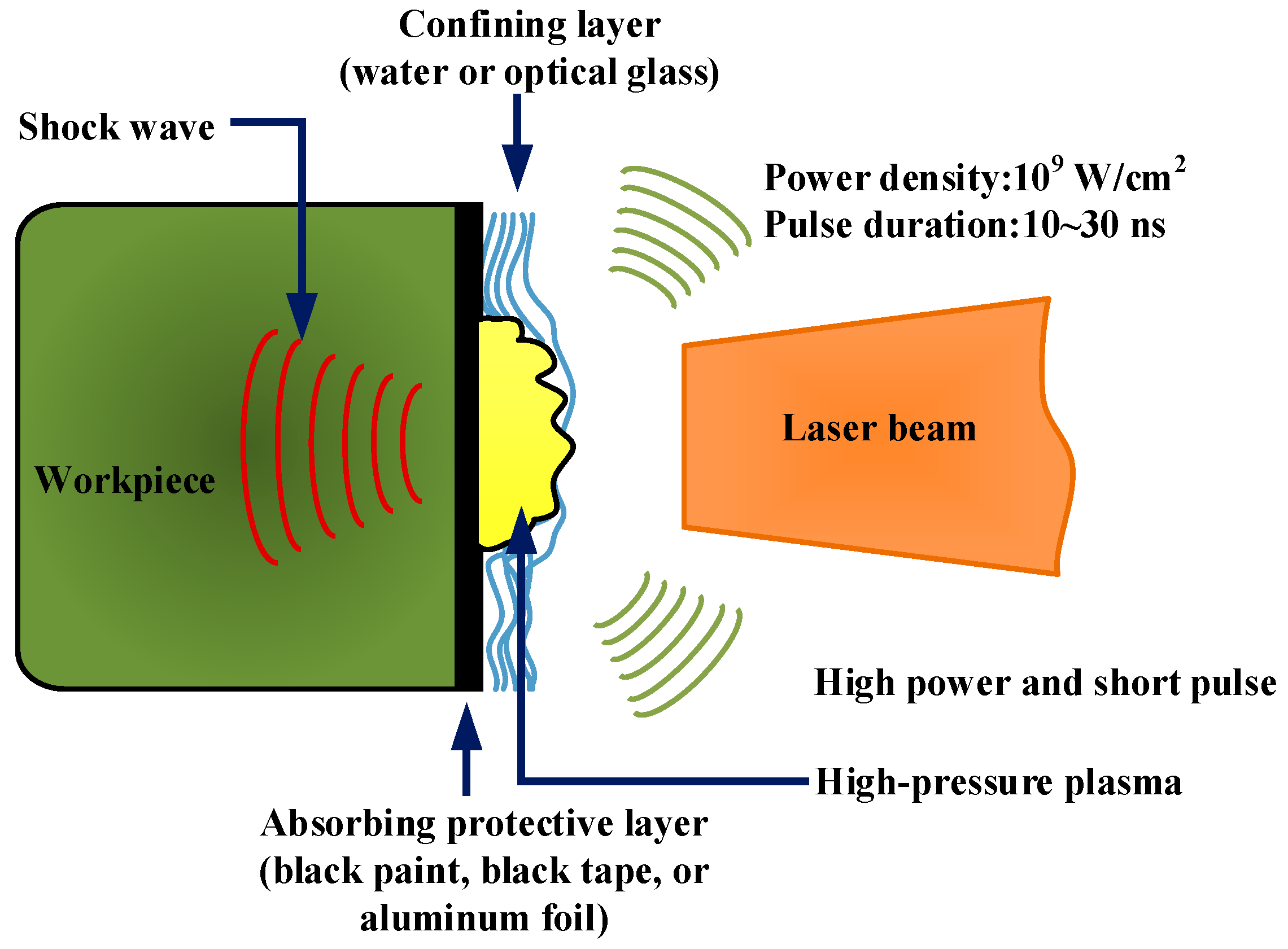

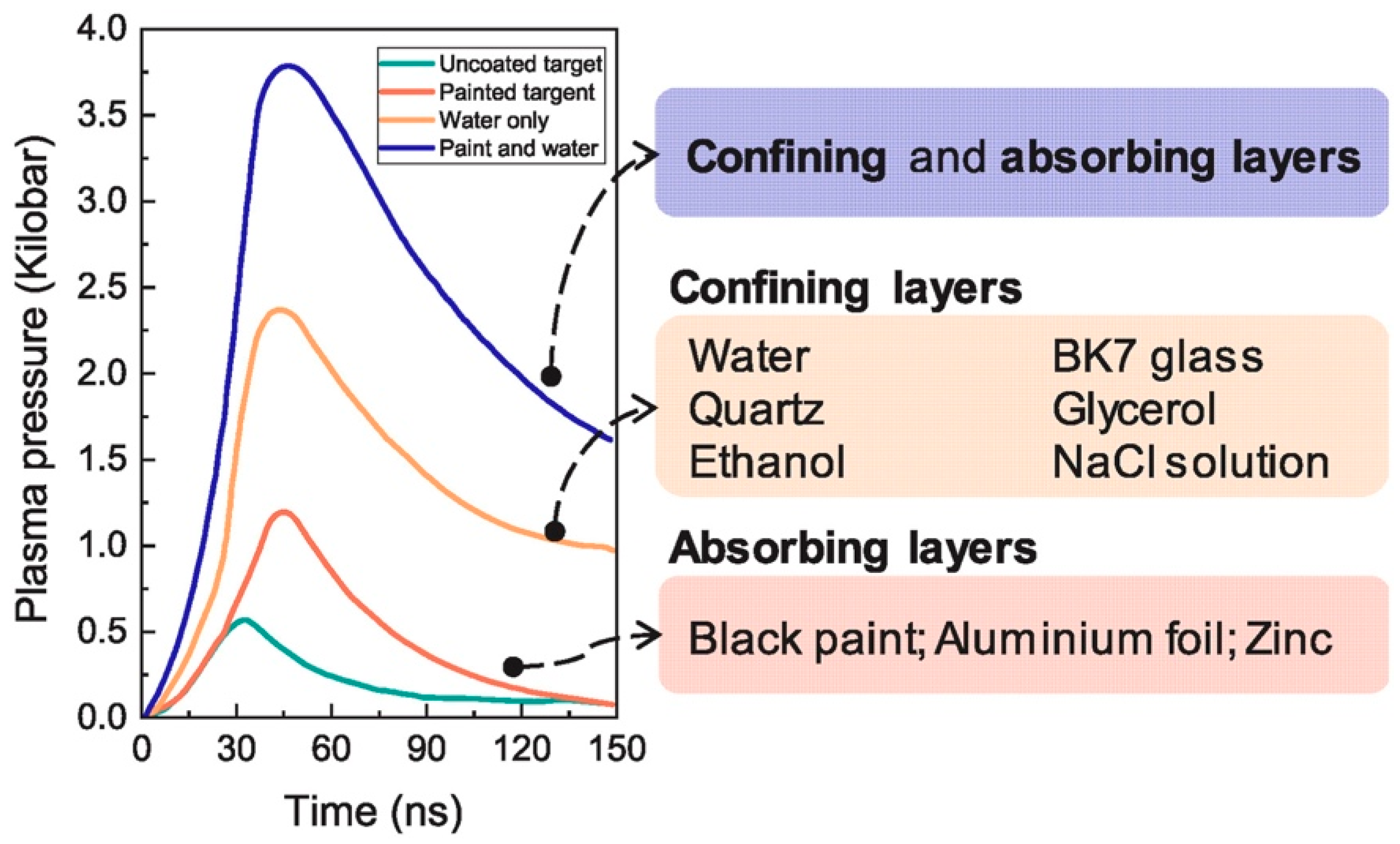
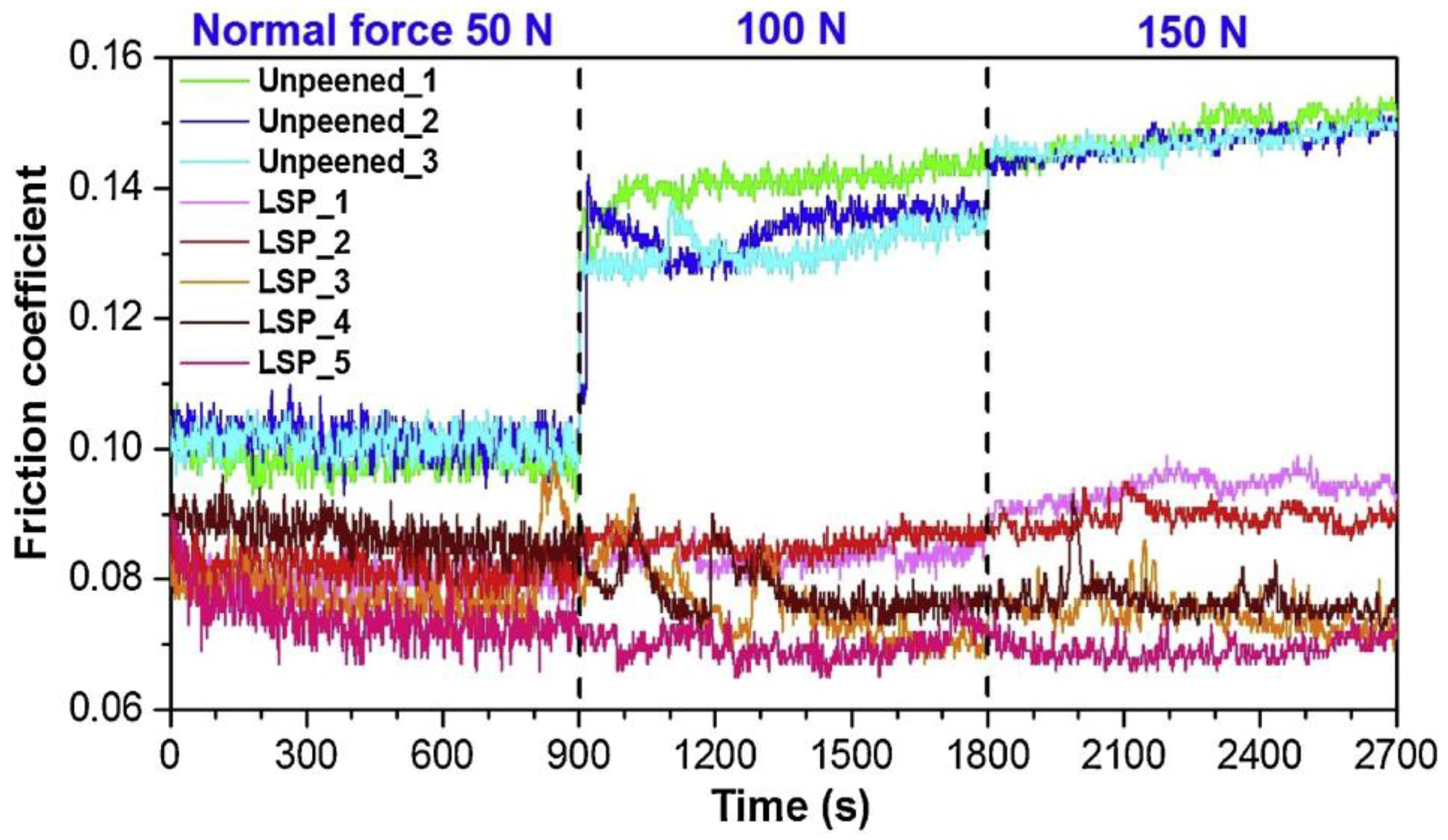
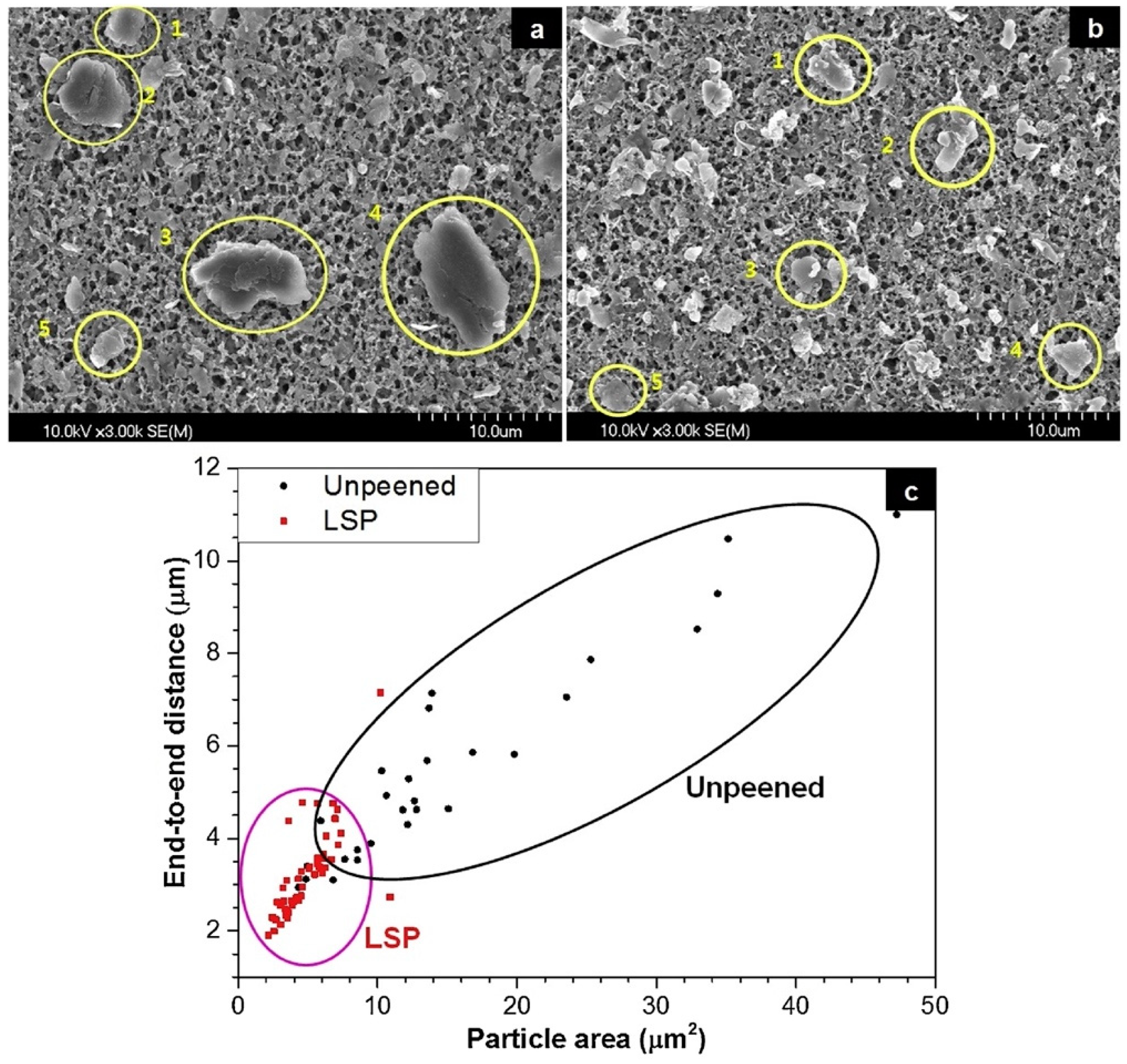
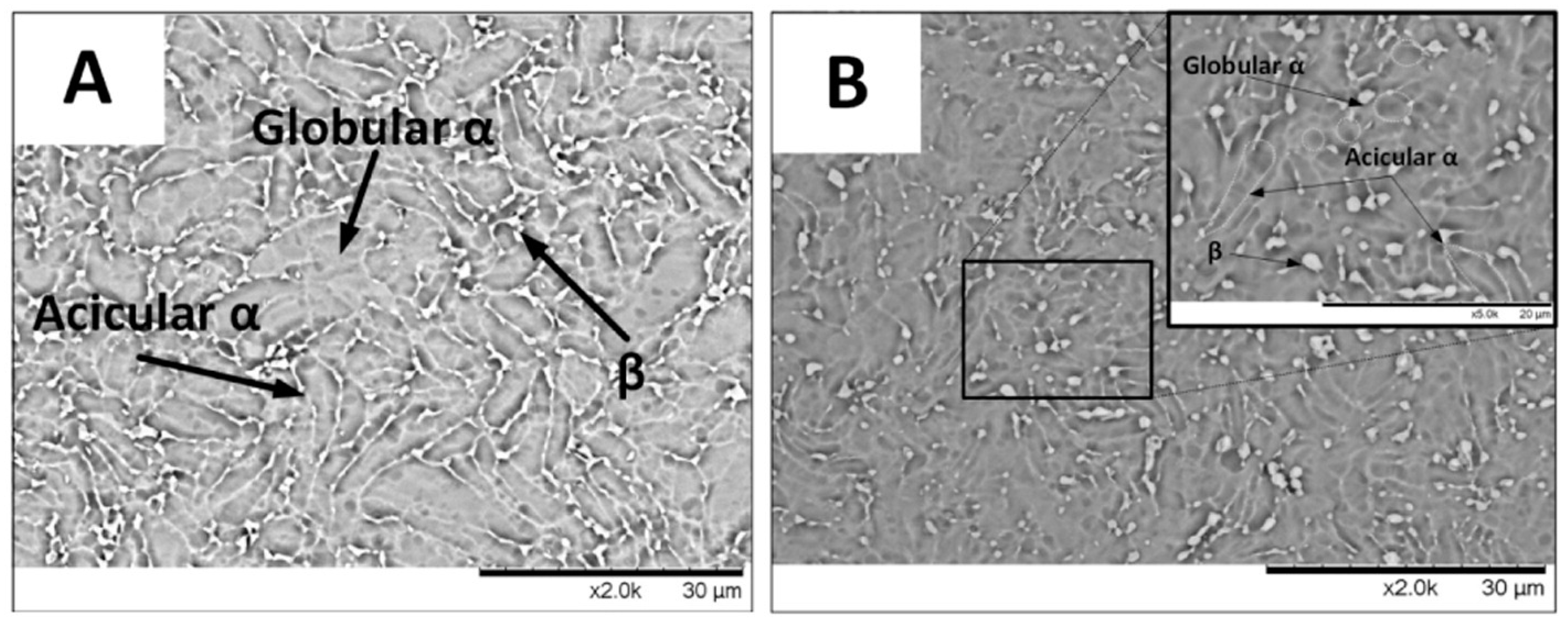
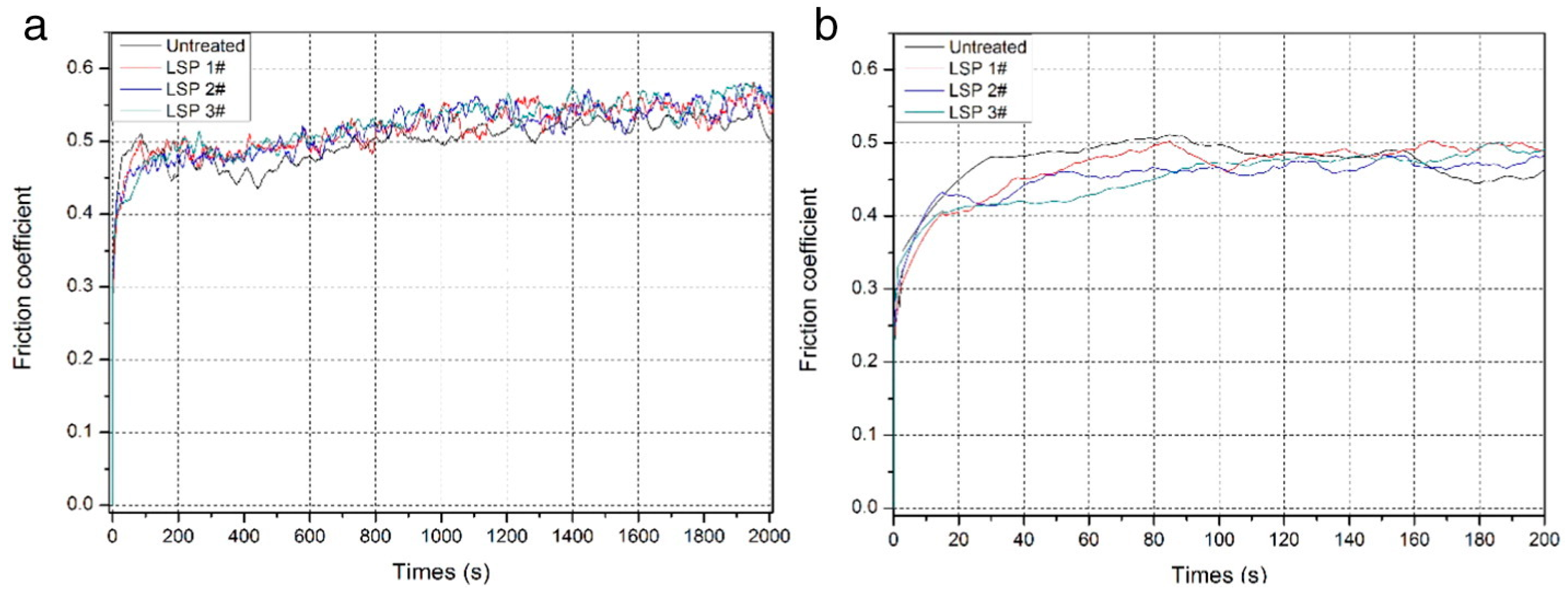
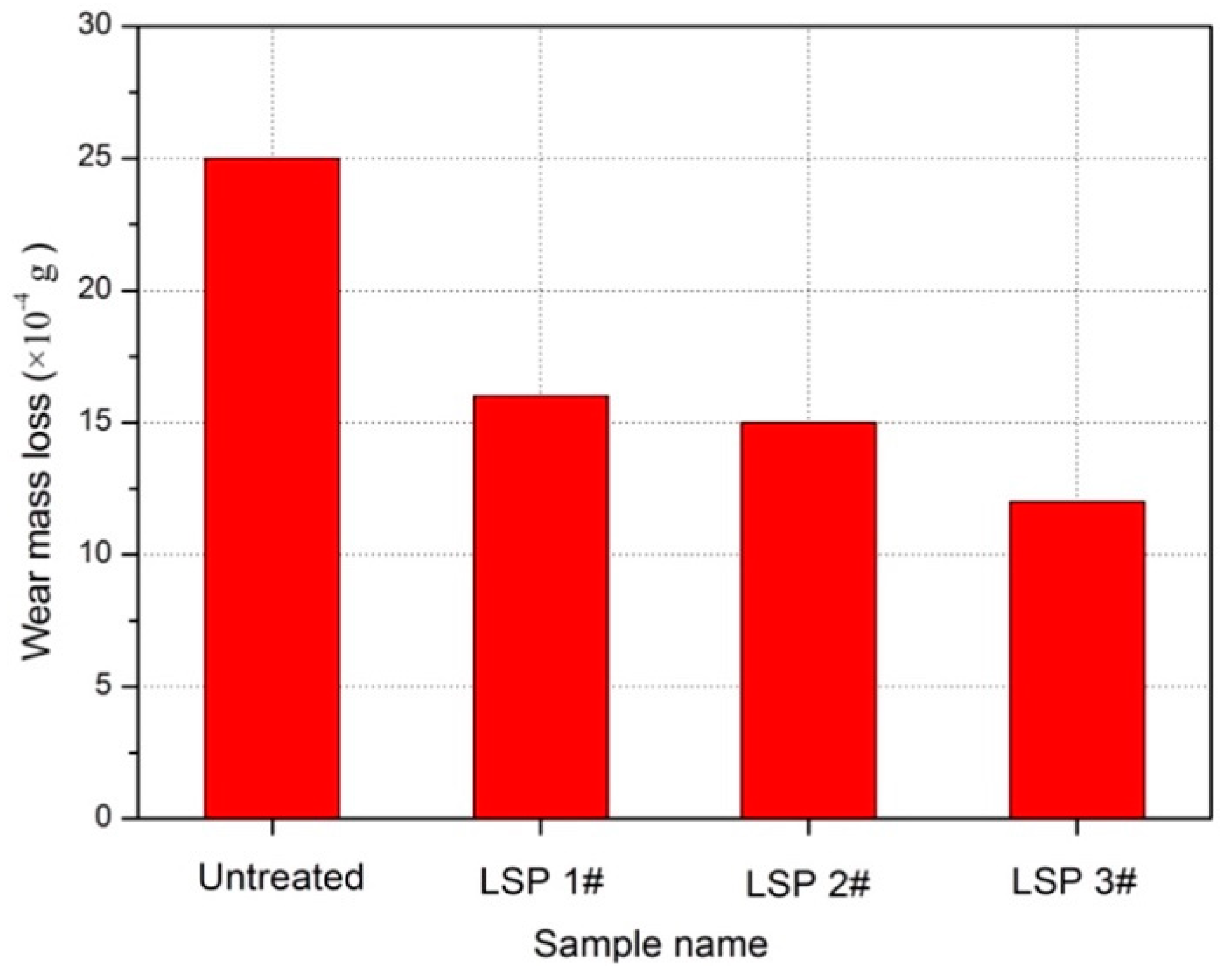
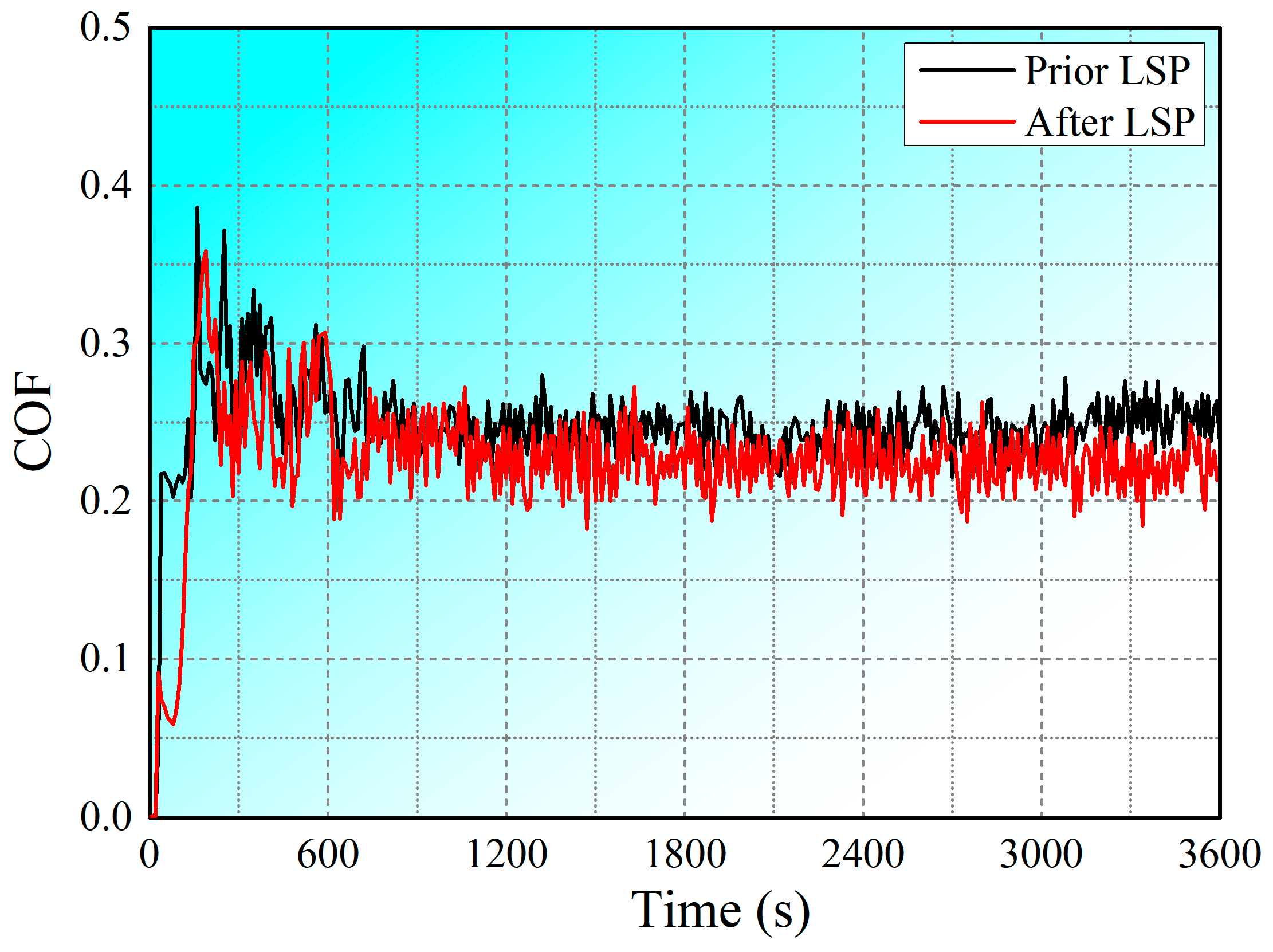
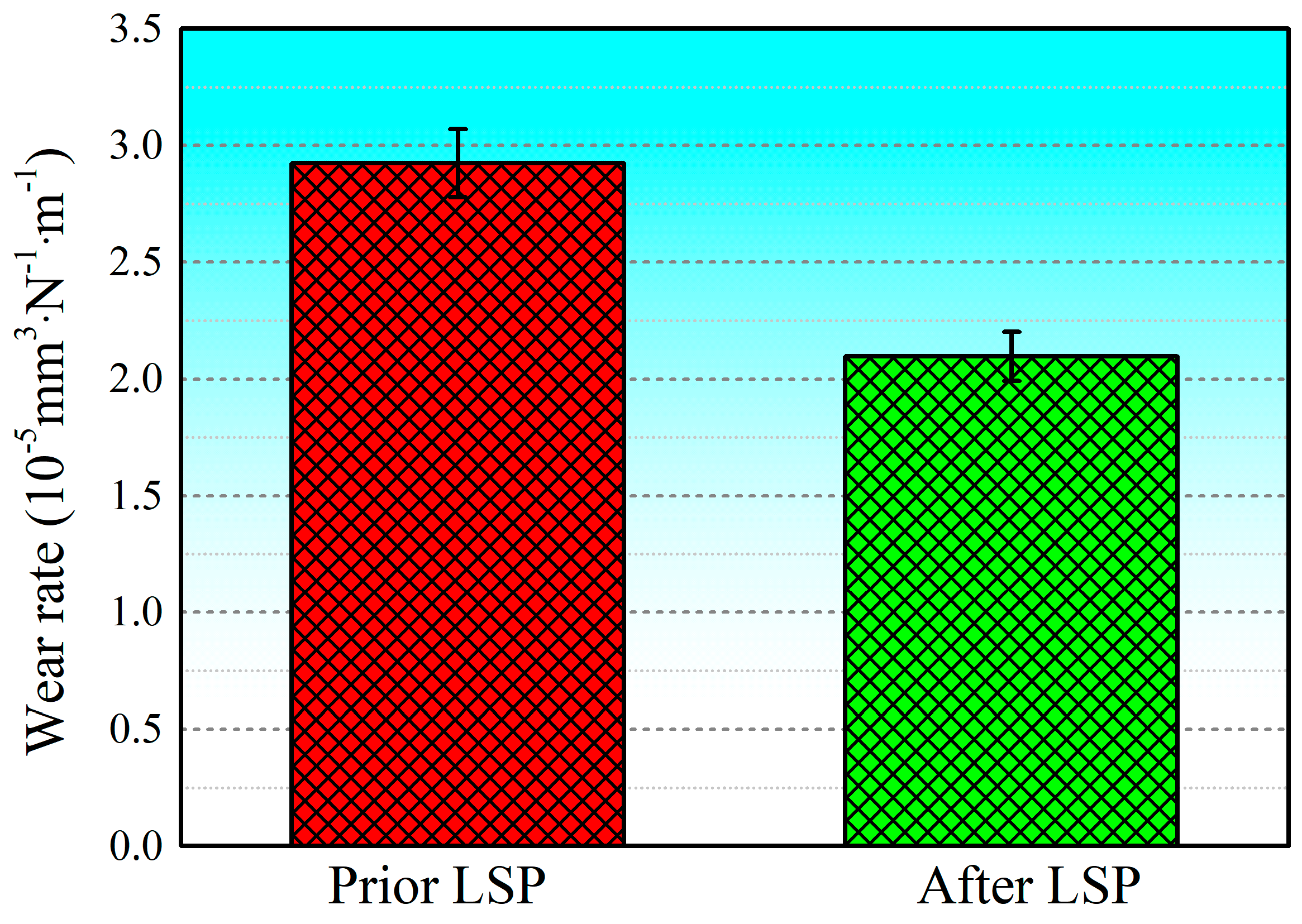
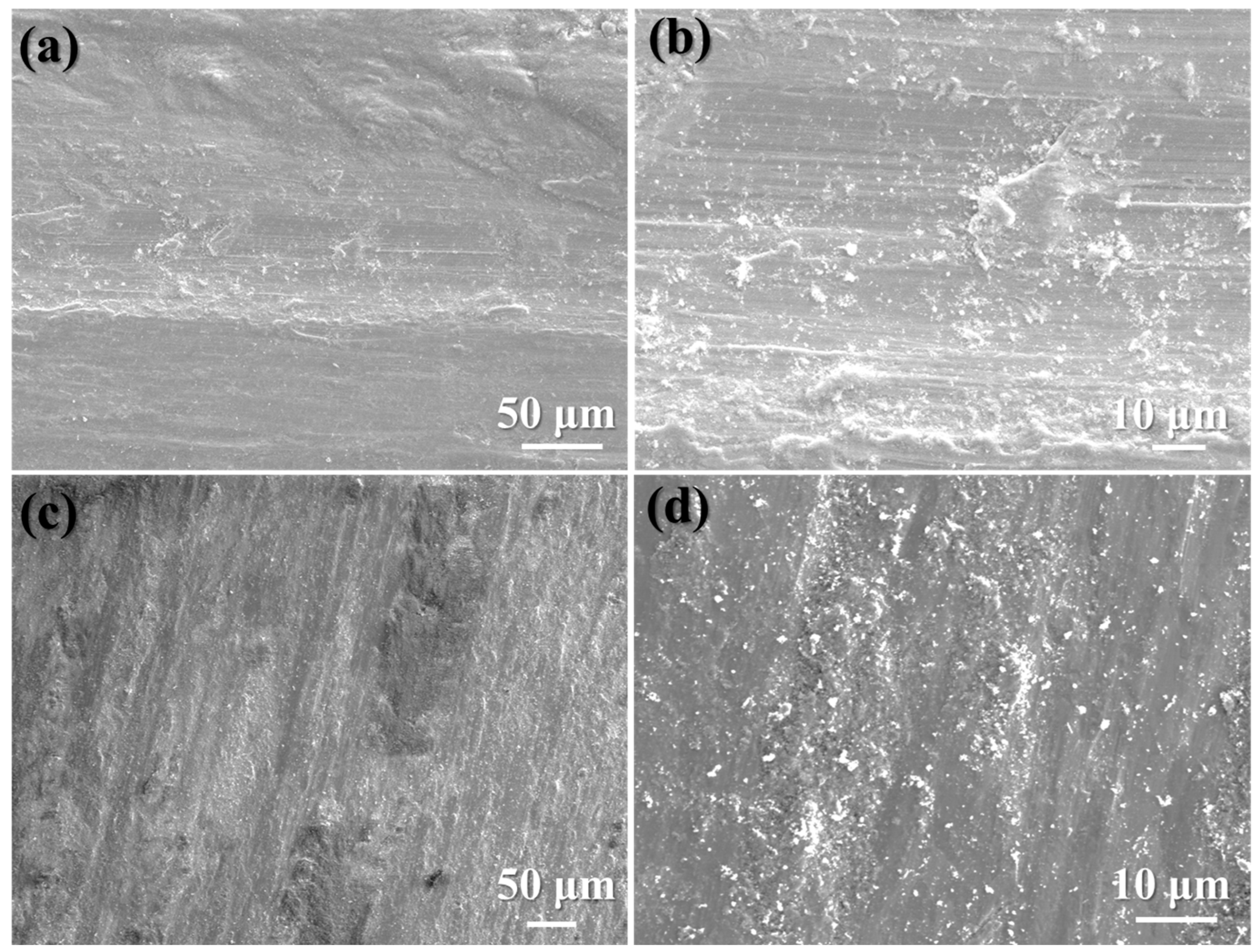
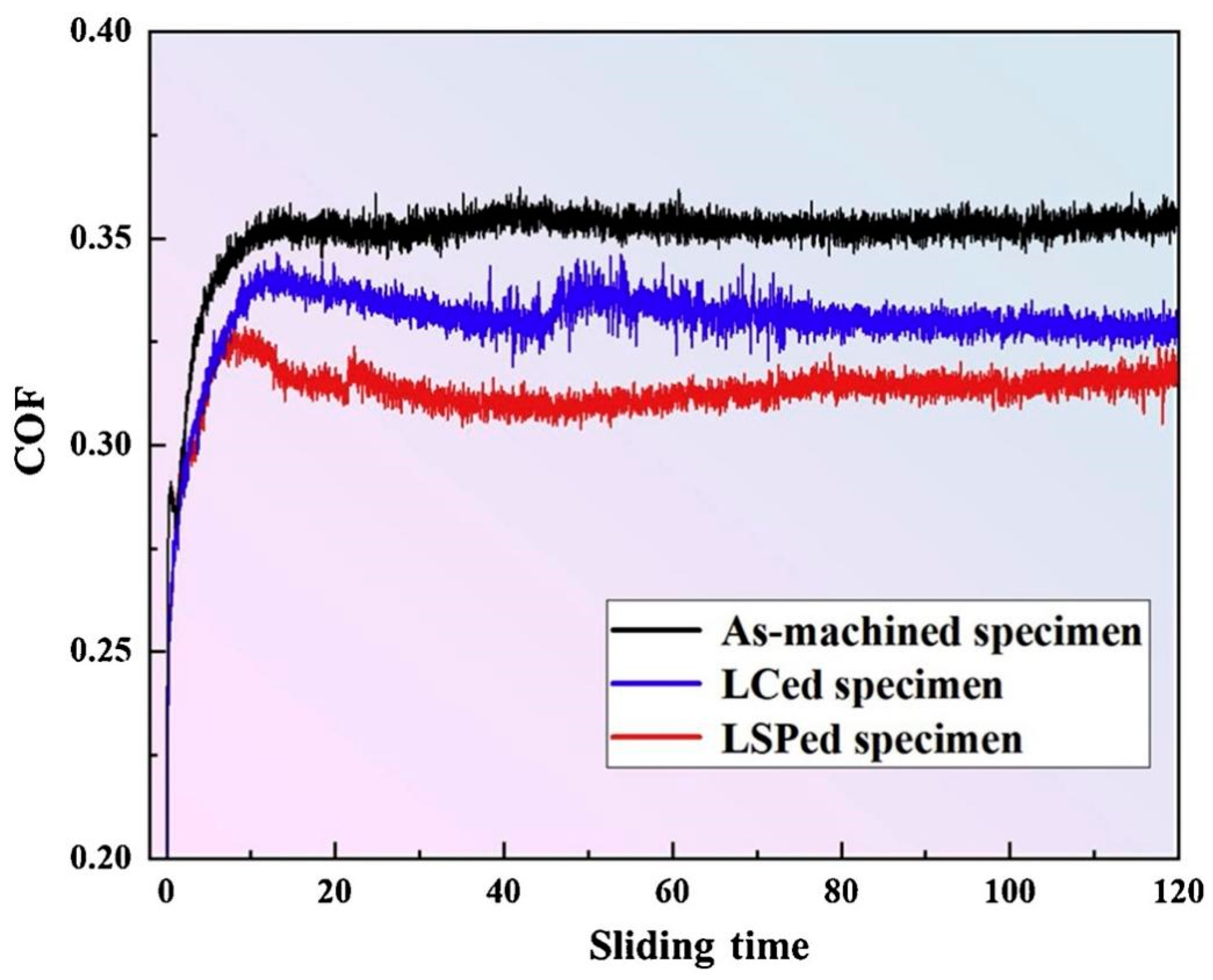
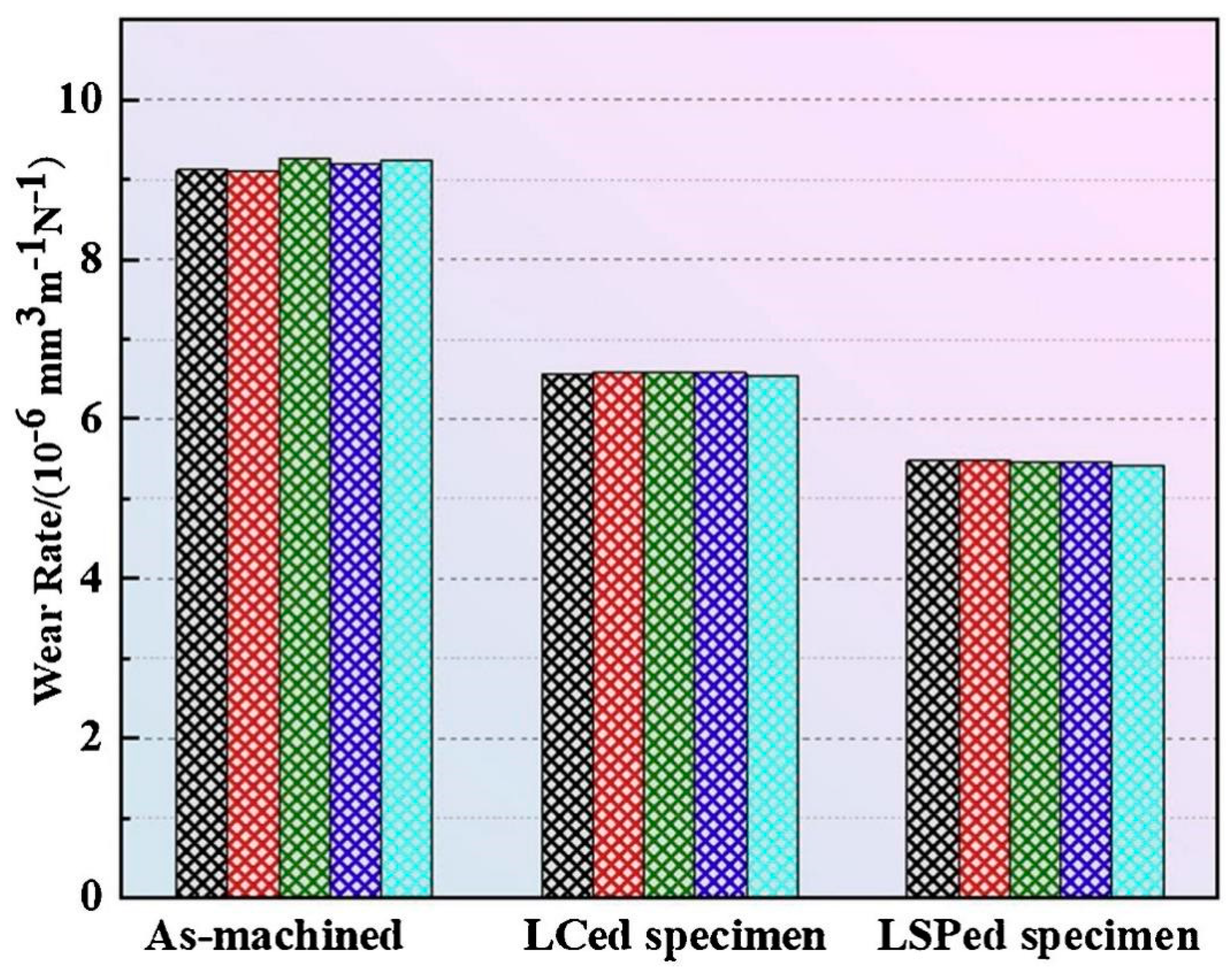

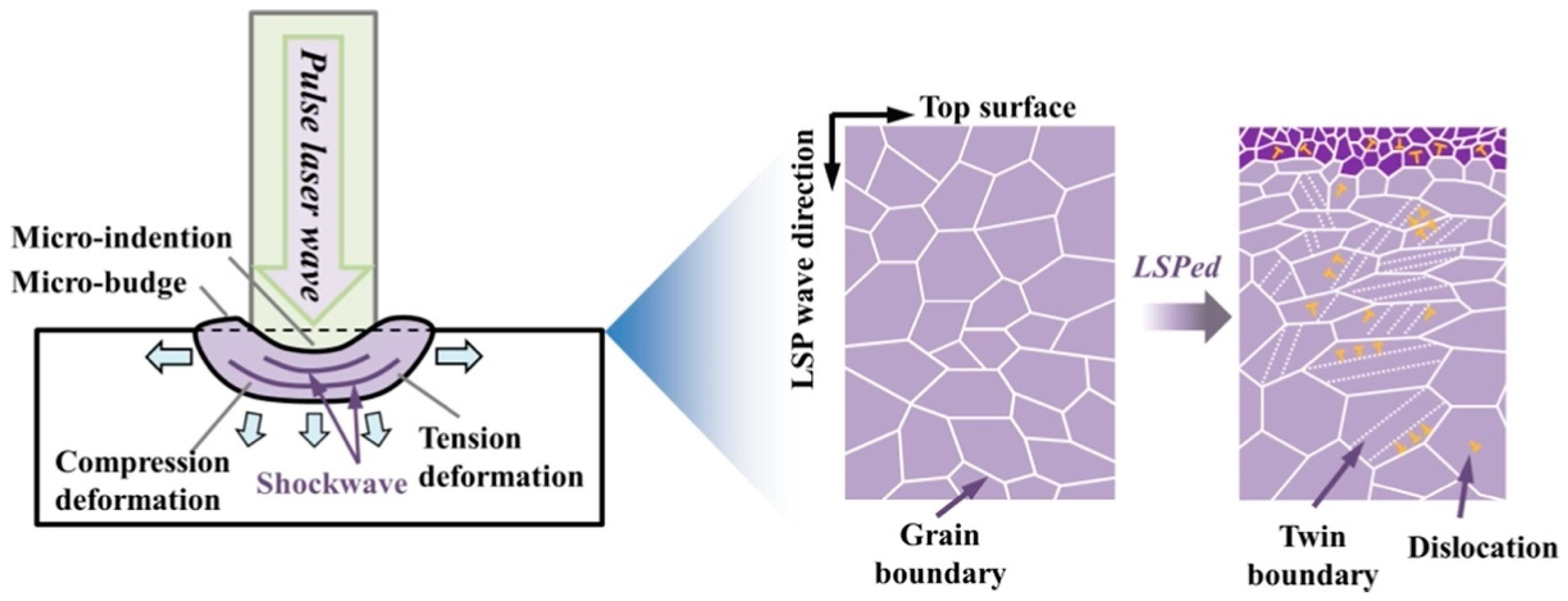
| Confining Layer Material | Advantages | Drawbacks | Application Scenario |
|---|---|---|---|
| Running water |
|
| Large-scale, room-temperature LSP |
| |||
|
| ||
| |||
| Glass |
|
| Small-scale LSP processing in laboratory settings |
|
| ||
| Glycerol |
|
| Large-scale, high-temperature sample processing |
|
|
| Before LSP | After LSP | ||
|---|---|---|---|
| Number of samples | 3 | 5 | |
| Average mass per sample (g) | Before test | 27.1725 | 27.3241 |
| After test | 27.1571 | 27.3232 | |
| Mass loss per sample (mg) | 15.4 (RSD = 7.5%) | 0.9 (RSD = 28.2%) | |
| Decrease in average mass loss (%) | 94 | ||
| Parameter | Untreated Specimen | LSP 1 | LSP 2 | LSP 3 |
|---|---|---|---|---|
| Surface microhardness (HV) | 310 | 363.2 | 367.5 | 372.2 |
| Work hardening depth (mm) | / | 0.9 | 0.9 | 0.9 |
| Parameter | Before LSP Treatment | After LSP Treatment |
|---|---|---|
| Surface residual stress (MPa) | 122 | −340 |
| Surface microhardness (HV) | 373.5 | 422.3 |
| Compress residual stress depth (mm) | / | 0.74 |
| Work hardening depth (mm) | / | 1 |
| Parameter | As-Machined Specimen | LC-Treated Specimen | LSP LC-Treated Specimen |
|---|---|---|---|
| Surface residual stress (MPa) | 0 | 167 | −453 |
| Surface microhardness (HV) | 250 | 432 | 550 |
| Compress residual stress depth (mm) | / | / | 1 |
| Work hardening depth (mm) | / | / | 0.8 |
Disclaimer/Publisher’s Note: The statements, opinions and data contained in all publications are solely those of the individual author(s) and contributor(s) and not of MDPI and/or the editor(s). MDPI and/or the editor(s) disclaim responsibility for any injury to people or property resulting from any ideas, methods, instructions or products referred to in the content. |
© 2024 by the authors. Licensee MDPI, Basel, Switzerland. This article is an open access article distributed under the terms and conditions of the Creative Commons Attribution (CC BY) license (https://creativecommons.org/licenses/by/4.0/).
Share and Cite
Cao, X.; Wu, J.; Zhong, G.; Wu, J.; Chen, X. Laser Shock Peening: Fundamentals and Mechanisms of Metallic Material Wear Resistance Improvement. Materials 2024, 17, 909. https://doi.org/10.3390/ma17040909
Cao X, Wu J, Zhong G, Wu J, Chen X. Laser Shock Peening: Fundamentals and Mechanisms of Metallic Material Wear Resistance Improvement. Materials. 2024; 17(4):909. https://doi.org/10.3390/ma17040909
Chicago/Turabian StyleCao, Xiaodie, Jiali Wu, Guisheng Zhong, Jiajun Wu, and Xinhui Chen. 2024. "Laser Shock Peening: Fundamentals and Mechanisms of Metallic Material Wear Resistance Improvement" Materials 17, no. 4: 909. https://doi.org/10.3390/ma17040909
APA StyleCao, X., Wu, J., Zhong, G., Wu, J., & Chen, X. (2024). Laser Shock Peening: Fundamentals and Mechanisms of Metallic Material Wear Resistance Improvement. Materials, 17(4), 909. https://doi.org/10.3390/ma17040909








